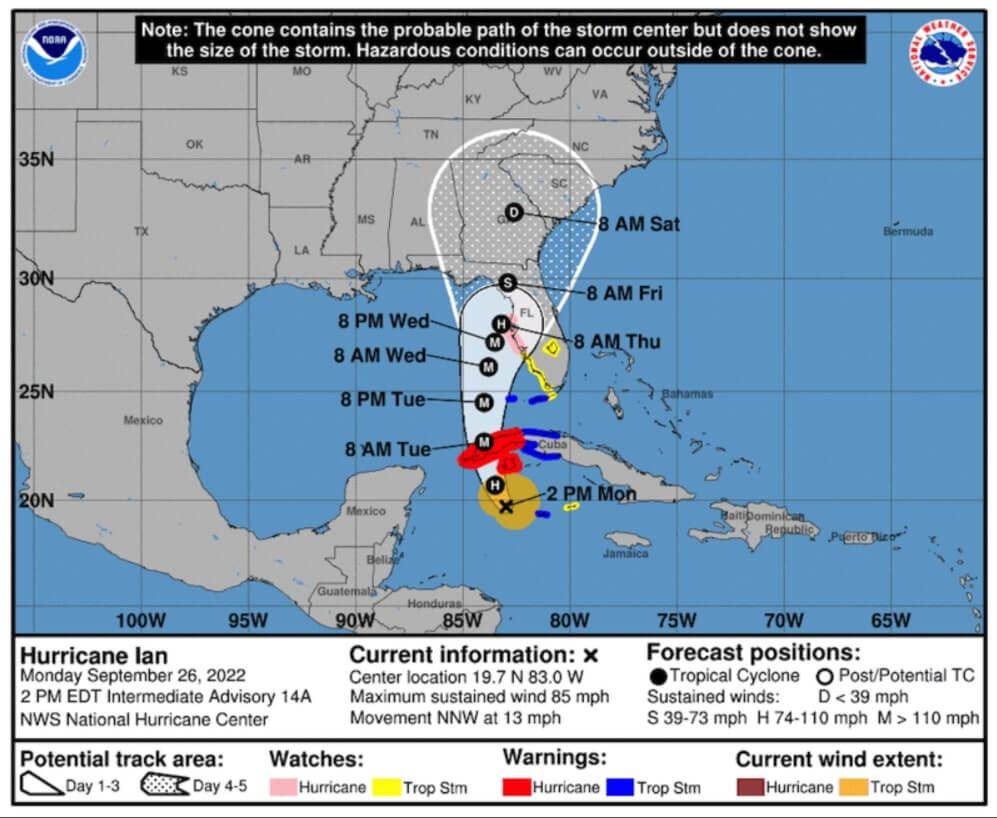Florida Prepares for Hurricane ‘Ian’

September 27, 2022
In Florida, people rushed to secure their houses with sandbags and get emergency supplies on Monday as Hurricane Ian barreled into the state with strong winds, heavy rainfall, and a strong storm surge.
After delaying the highly anticipated trip for the third time, Ian’s route toward Florida caused NASA to roll its massive Artemis 1 moon rocket off its Cape Canaveral launchpad.
As of Monday afternoon, Ian was a Category 1 hurricane and was projected to strengthen before reaching landfall in Cuba by nightfall. After Ian departed Cuba, forecasters predicted that the storm might make landfall early on Friday morning north of Tampa Bay or move northwest toward Florida’s Panhandle.
At a press conference, Florida Governor Ron DeSantis said, “This is a truly massive storm. It has the ability to cover both sides of the state.”
Due to climate change, storms have been wetter, windier, and more powerful in Florida in recent years. There is evidence that storms are moving more slowly as a result of climate change, which allows them to dump more water in one location.
There were warning signs all around Florida, a state with 21 million residents. Crews cut palm palms in Titusville, a 43,000-person city on the Atlantic coast, using chainsaws. Where the business usually has distilled water on hand, empty cardboard boxes were all that was left in a supermarket store in St. Petersburg, across the state on the Gulf Coast. Cans of soup, crackers, and toilet paper were still available.
Diane Zambito, 64, of Ybor City, a historic district in Tampa, said she often isn’t alarmed by hurricanes that affect the state.
She said, “But this one’s different,” as her husband fastened plywood over the windows of their house on Monday afternoon. “I’m scared about this one. If you have any sense, it’s too massive not to be frightened. To stop water from entering the house, the couple intended to scoop sand into sacks and stack them in front of the doorways.
Many Floridians were ready for flooding that would swamp streets and houses, including the Zambitos. Forecasters caution that a hurricane-force storm could cause power disruptions, damage, or even demolish homes and businesses in the upcoming days.
A total of 5,000 members of the National Guard have been activated by the governor. And another 2,000 are on their way from Tennessee, Georgia, and North Carolina. Other states nearby have troops on standby.
#HappeningNow USCG Sector St Pete set Port Condition YANKEE for #HurricaneIan, closing the port to inbound traffic. A flight survey of #Tampabay area ports was also completed. Follow @NWSTampaBay for storm updates. Port conditions in Tampa Bay at https://t.co/lNWbbov5Oh pic.twitter.com/3REDjSpKYx
— USCGSoutheast (@USCGSoutheast) September 26, 2022
Teri Johnston, the mayor of Key West, said that her island community would be among those in the United States if Hurricane Ian strikes first.
Johnston claimed that while inhabitants stored up on enough food and water to last a week, homes and holiday rentals nailed up storm shutters or boards over windows. She added: “A coconut may become a 30-pound missile in a storm. The city has even taken down the coconuts from the coconut trees that are in some neighborhoods.”
Before storm squalls begin to batter the city on Monday night, city cars were moved to higher ground, and citizens living on boats were advised to seek cover on land. A 4-foot (1.2-meter) storm surge that may force seawater over the shore and into the streets was anticipated by forecasters.
“I’ll be the one to give the order for an evacuation,” Johnston said. If the storm moves east, we’ll take it into consideration.
On Monday morning, the storm was roughly 100 miles (160 km) southwest of Grand Cayman and had sustained winds of 80 mph (128 km per hour). Two installations in the Gulf of Mexico had their oil production stopped by BP Plc.
Forecasters predict that Ian might become a Category 3 hurricane after it crosses the Gulf of Mexico. But it will likely lose strength once it is parked off Tampa on Florida’s Gulf Coast on Thursday. The storm’s course is less certain after that.
However, according to Bob Oravec, a meteorologist with the National Weather Service’s Weather Prediction Center in College Park, Maryland, between 6 and 12 inches (15 to 30 cm) of rain were anticipated to inundate both Florida’s Gulf and Atlantic coasts on Thursday.
Ian follows Hurricane Fiona, a devastating Category 4 storm. It tore across Puerto Rico last week and left the majority of the U.S. territory without electricity or drinkable water. After that, Fiona plowed past the Turks and Caicos Islands, avoided Bermuda, and crashed into Canada’s Atlantic coast, where it might take months to repair crucial infrastructure.
Also Read: Warning for Shipping After Major Gas Leak From Nord Stream 2 Pipeline
Click here to join our Telegram chanel
You will get information, news, and support related to Merchant Navy.
